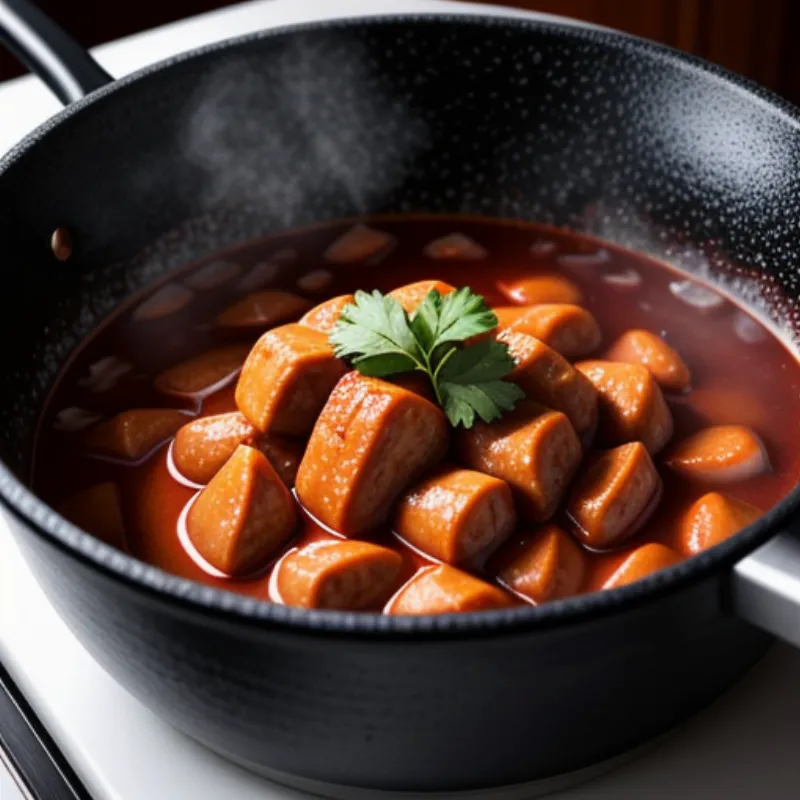Sambal Bajak is a beloved Indonesian chili paste known for its intense heat and savory depth. Unlike other sambals, it features coarsely ground chilies, creating a delightful texture that bursts with flavor. This versatile condiment is perfect for adding a fiery kick to any dish, from grilled meats and seafood to noodles and rice.
What is Sambal Bajak?
Sambal Bajak hails from West Java, Indonesia, where it’s a staple in many households. The name “Bajak” itself refers to a type of plow, hinting at the paste’s rough, coarsely ground texture. It’s this texture, combined with the intense heat of the chilies, aromatic spices, and a hint of sweetness, that makes Sambal Bajak truly unique.
Ingredients You’ll Need
Main Ingredients
- 200g Red chilies, a mix of bird’s eye chilies and larger chilies for balanced heat (Adjust to your spice preference!)
- 100g Shallots, peeled and roughly chopped
- 50g Garlic, peeled
- 2 tbsp Tomato paste (Adds a subtle tanginess and deepens the color)
- 50ml Vegetable oil (Use a neutral oil like canola or sunflower)
Spices and Seasonings
- 1 tbsp Coriander seeds
- 1 tsp Cumin seeds
- 1 tsp Salt (Adjust to taste)
- 1 tbsp Palm sugar or brown sugar (Adds a hint of sweetness and balances the heat)
Tools of the Trade
- Large frying pan or wok
- Mortar and pestle or food processor
- Jar for storage
Let’s Make Sambal Bajak!
Step 1: Toasting the Spices
- In a dry frying pan over medium heat, toast the coriander and cumin seeds until fragrant, about 2-3 minutes. Be careful not to burn them!
- Once fragrant, remove from heat and let cool slightly.
Step 2: Blending the Ingredients
- In a mortar and pestle or food processor, combine the toasted coriander and cumin seeds with the shallots, garlic, and salt.
- Grind or blend until you achieve a coarse paste. It doesn’t need to be completely smooth, a little texture is what we’re after!
Step 3: Frying the Sambal
- Heat the vegetable oil in a frying pan or wok over medium heat.
- Add the chili paste and fry, stirring constantly, until fragrant and the oil starts to separate, about 5-7 minutes.
Step 4: Adding the Final Touches
- Stir in the tomato paste and sugar, and continue to cook for another 2-3 minutes. The sambal should be thickened and darkened in color.
Step 5: Cooling and Storing
- Remove the sambal from heat and let cool completely before transferring it to a sterilized jar.
- Store in the refrigerator for up to 2 weeks.
Tips and Tricks
- Spice Level: Sambal Bajak is known for its heat! Adjust the number of chilies to your preference. You can also remove some of the seeds for a milder sambal.
- Texture: For a smoother sambal, blend the ingredients for longer. If you prefer a chunkier texture, pulse the ingredients in a food processor or use a mortar and pestle.
- Sweetness: The amount of sugar can be adjusted to your liking. Start with 1 tablespoon and add more if desired.
- Serving: Sambal Bajak is incredibly versatile! Serve it as a condiment alongside grilled meats, chicken, fish, tofu, or vegetables. Mix it into noodles or rice for an extra kick, or use it as a base for your favorite Indonesian dishes.
FAQs about Sambal Bajak
Can I make Sambal Bajak ahead of time?
Absolutely! Sambal Bajak actually tastes even better the next day after the flavors have had time to meld.
What can I substitute for palm sugar?
Brown sugar makes a great substitute for palm sugar. You can also use regular granulated sugar, but you may need to adjust the amount to taste.
How long does Sambal Bajak last in the fridge?
Stored properly in an airtight container in the refrigerator, Sambal Bajak will last for up to 2 weeks.
Exploring the World of Sambal
Sambal Bajak is just one of many delicious sambal varieties found in Indonesia. Each region boasts its own unique recipe, using different chilies, spices, and cooking methods.
“I always encourage home cooks to experiment with different sambal recipes,” says Chef Rani, a renowned Indonesian chef and cookbook author. “Sambal making is an art form, and there’s always something new to discover.”
 Sambal Bajak Ingredients
Sambal Bajak Ingredients
 Cooking Sambal Bajak
Cooking Sambal Bajak
So why not embark on a culinary adventure and try making your own Sambal Bajak? It’s easier than you think, and the rewards are well worth the effort. Once you taste the fiery, complex flavors of this Indonesian condiment, you’ll be hooked! Don’t forget to share your experience and photos with us in the comments below! We’d love to hear your thoughts.
